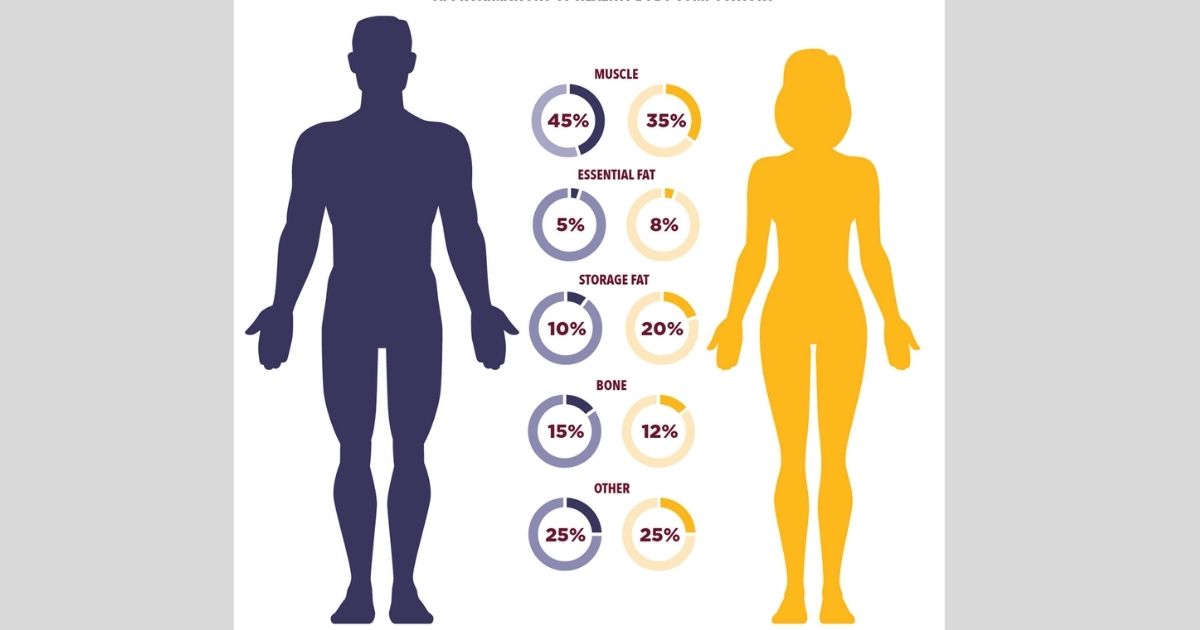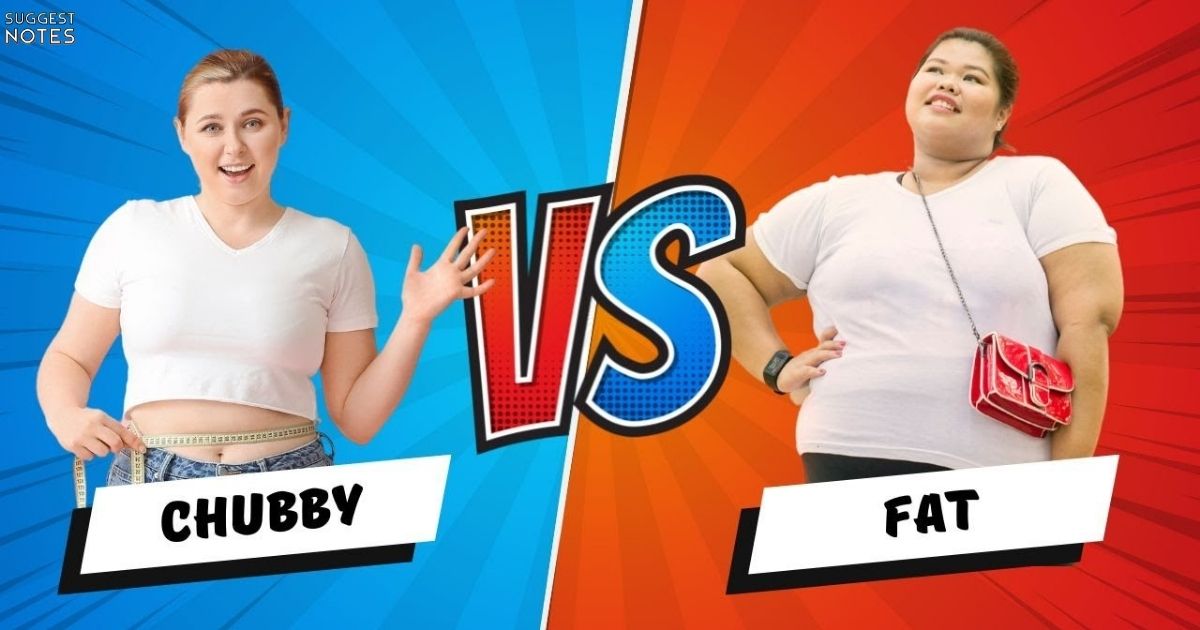In today’s society, body image and weight are hot topics, with people using terms like “chubby” and “fat” to describe various body types. However, there’s often confusion regarding the exact meaning and implications of these terms. Understanding the difference between “Chubby vs Fat” is crucial not only for improving body image but also for identifying health risks associated with different body compositions.
This article explores the physical, genetic, and lifestyle factors that define “chubby” and “fat” body types, helping readers grasp the differences between the two in terms of health, appearance, and self-perception.
What Does “Chubby” Really Mean?

When people refer to someone as “chubby,” they generally describe a person with some extra weight, but not to the point where it severely affects their health. Chubby individuals tend to have:
- A softer, rounder appearance.
- Fuller cheeks and limbs.
- A balanced weight that may still fall within or just above the healthy range.
In the “Chubby vs Fat” debate, being chubby typically implies a more moderate level of body fat accumulation, and in many cases, it doesn’t come with the serious health risks often associated with higher degrees of fat. Chubby individuals often maintain good physical health, and their extra weight is evenly distributed across the body rather than concentrated in specific areas.
Cultural Perception of “Chubby”
The term “chubby” is generally perceived as less offensive or stigmatizing than “fat.” In many cultures, being chubby is even seen as a sign of good health and vitality. While societal pressures and media can sometimes promote ultra-thin ideals, a chubby body type is often accepted as part of a healthy, diverse body spectrum.
Defining “Fat” – Medical vs. Colloquial Usage
Medically, the term “fat” refers to the accumulation of adipose tissue, which serves essential functions like storing energy, insulating the body, and producing hormones. However, in everyday language, being called “fat” often carries a negative connotation. In the “Chubby vs Fat” comparison, “fat” refers to a larger amount of excess weight that may pose more significant health risks.
Fat is stored in two main forms in the body:
- Subcutaneous fat: Fat that lies just beneath the skin.
- Visceral fat: Fat that surrounds internal organs and is more closely linked to health risks.
In the context of “Chubby vs Fat,” individuals described as “fat” usually have more pronounced fat deposits in specific areas, such as the abdomen, thighs, or hips. This accumulation can result in a larger waistline, which is often associated with an increased risk of heart disease, diabetes, and other metabolic conditions.
BMI: A Common but Flawed Metric
Body Mass Index (BMI) is the most commonly used tool to classify body weight. It is calculated by dividing a person’s weight (in kilograms) by the square of their height (in meters). While BMI can provide a general indication of body weight categories, it does not differentiate between fat and muscle, nor does it account for fat distribution in the body.
BMI Ranges:
| BMI Range | Classification |
|---|---|
| Below 18.5 | Underweight |
| 18.5 – 24.9 | Normal weight |
| 25.0 – 29.9 | Overweight |
| 30.0 and above | Obese |
In the “Chubby vs Fat” context, BMI can be misleading. For example, someone with a BMI of 29 might be considered overweight, but if they have a significant amount of muscle, they may actually be healthy. Conversely, someone with a lower BMI but a high body fat percentage might be at greater risk of metabolic diseases. Therefore, it’s essential to look beyond BMI to more comprehensive measures of health, such as body composition and fat distribution.
Related Guide:
Decoding Facebook Messaging: Sent Vs Delivered
Limitations of BMI in Assessing “Chubby vs Fat”

BMI fails to provide a complete picture of health because:
- It doesn’t account for muscle mass: Athletes with significant muscle mass might have a high BMI, yet they are far from fat.
- It overlooks fat distribution: BMI doesn’t show whether a person carries most of their fat in the abdominal area (which is riskier) or more evenly across the body.
- It may misclassify body types: Someone who is chubby might fall into the overweight category based on BMI, while a person with higher health risks might still be classified as normal weight.
Dr. Margaret Ashwell, former Science Director of the British Nutrition Foundation, highlights this by saying, “BMI is an imperfect measure of body fat content and does not take into account muscle mass, bone density, overall body composition, and racial and sex differences.” The “Chubby vs Fat” comparison becomes more relevant when considering these factors.
The Science Behind Body Composition
Body composition refers to the proportion of fat, muscle, bone, and water in the body. Understanding body composition is key to distinguishing between “Chubby vs Fat.” Two people may weigh the same, but their health and appearance can differ drastically depending on their body fat percentage and muscle mass.
Fat Cells: Important but in Moderation
Fat cells, also known as adipocytes, play important roles in the body:
- Energy storage: Fat stores calories for later use when energy is needed.
- Hormone regulation: Fat tissue secretes hormones like leptin, which helps regulate hunger and metabolism.
- Insulation and protection: Fat provides cushioning for vital organs and helps insulate the body against cold temperatures.
However, excess fat, particularly visceral fat (which surrounds internal organs), can lead to metabolic disturbances. This is why it’s important to understand the difference between “Chubby vs Fat.” A person who is fat is more likely to have an unhealthy amount of visceral fat, which contributes to conditions such as insulin resistance and heart disease.
Types of Fat in the Body

When analyzing “Chubby vs Fat,” it’s essential to understand the different types of fat:
- Subcutaneous fat: Located directly beneath the skin, it is relatively harmless and may contribute to a “chubby” appearance.
- Visceral fat: Found deeper in the body, surrounding internal organs, it’s associated with higher risks of metabolic conditions, including type 2 diabetes and cardiovascular diseases.
- Brown fat: A special type of fat that helps burn calories and regulate body temperature. Higher levels of brown fat are generally considered beneficial.
People classified as “fat” in the “Chubby vs Fat” discussion often have higher levels of visceral fat, which is why their health risks can be more severe.
Muscle Mass: The Hidden Factor
Muscle mass significantly influences body composition. The more muscle you have, the higher your metabolism because muscle burns more calories than fat, even when you’re at rest. In the “Chubby vs Fat” context, a person with more muscle may have a fuller, healthier look despite weighing more than someone with less muscle.
Having more muscle mass can:
- Improve overall metabolic health.
- Enhance physical appearance and strength.
- Offset the risks associated with higher body fat.
This is why strength training is often recommended for improving body composition and is especially beneficial for individuals who fall into the “chubby” category of the “Chubby vs Fat” spectrum.
Body Fat Percentage: A More Telling Metric
Rather than relying solely on BMI, body fat percentage is a more accurate indicator of health and fitness. The body fat percentage measures the proportion of fat in relation to total body weight. Here’s a guide to healthy body fat ranges:
| Classification | Women (% body fat) | Men (% body fat) |
|---|---|---|
| Essential fat | 10-13% | 2-5% |
| Athletes | 14-20% | 6-13% |
| Fitness | 21-24% | 14-17% |
| Average | 25-31% | 18-24% |
| Obese | 32%+ | 25%+ |
When comparing “Chubby vs Fat,” body fat percentage is a better indicator of health. Chubby individuals tend to have a lower body fat percentage, while those classified as “fat” may have higher percentages, especially when it comes to visceral fat.
Genetic Factors: Nature’s Blueprint
Genetics play a critical role in determining how your body stores fat, builds muscle, and shapes your overall body composition. This is important when considering the “Chubby vs Fat” distinction, as some people are genetically predisposed to carry more weight in certain areas of their bodies, such as the hips, thighs, or abdomen.
How Genetics Influence Fat Distribution
Some people naturally carry more weight in their hips and thighs (commonly referred to as a pear-shaped body), while others store fat primarily in the midsection (apple-shaped). These patterns of fat distribution are largely dictated by genetics. For example:
- Pear-shaped bodies: Tend to store fat in the lower body, which is less associated with health risks.
- Apple-shaped bodies: Tend to store more visceral fat in the abdominal region, which is linked to higher risks of heart disease and type 2 diabetes.
Understanding these genetic factors helps clarify the “Chubby vs Fat” comparison, as some individuals may appear chubbier due to their genetic makeup but still have a healthy body composition.
The Role of the “Obesity Gene”
While there’s no single “obesity gene,” certain genetic variations can predispose individuals to gain weight more easily or struggle to lose it. Some of the genes involved include:
- FTO gene: Linked to increased appetite and calorie consumption.
- MC4R gene: Affects hunger and satiety.
- INSIG2 gene: Influences fat storage.
However, lifestyle factors such as diet, exercise, and stress can either amplify or mitigate the effects of these genes. This is why even if someone has a genetic predisposition toward gaining fat, they can still manage their weight and health through lifestyle choices, making the “Chubby vs Fat” distinction more about behavior than just biology.
Lifestyle’s Role in Body Composition
Lifestyle choices significantly affect body composition and contribute to whether someone is classified as chubby or fat. Diet, exercise, sleep, and stress levels all influence the balance between muscle and fat in the body.
Diet: Fueling Your Body Properly
Diet is one of the most crucial factors in determining body composition. A balanced, nutrient-rich diet helps maintain a healthy balance of fat and muscle. On the other hand, a diet high in processed foods, sugars, and unhealthy fats contributes to fat accumulation, particularly visceral fat.
Key dietary principles include:
- Whole foods over processed foods: Eating whole grains, vegetables, fruits, and lean proteins provides the body with essential nutrients without the excess calories that contribute to fat gain.
- Healthy fats over trans fats: Choosing sources of healthy fats like avocados, nuts, and olive oil helps maintain proper hormone function and supports overall health, while trans fats promote visceral fat accumulation.
Exercise: The Muscle vs Fat Equation
Regular exercise plays a major role in body composition by helping burn fat, build muscle, and improve metabolic health. In the “Chubby vs Fat” comparison, physical activity can prevent excess fat accumulation and promote lean muscle development.
- Strength training: Essential for building muscle mass, increasing metabolism, and improving body shape.
- Cardiovascular exercise: Burns calories and improves heart health, helping reduce body fat levels.
The right combination of exercise helps individuals maintain a healthier muscle-to-fat ratio, making the difference between being chubby and fat.
Sleep and Stress: Hidden Influencers
Sleep and stress are often overlooked factors that have a profound impact on body composition. A lack of sleep or chronic stress can promote weight gain and increase fat accumulation, particularly around the abdomen.
- Sleep deprivation disrupts hormones like ghrelin and leptin, which regulate hunger and satiety. As a result, people tend to eat more and store more fat.
- Chronic stress leads to elevated levels of cortisol, a hormone that encourages fat storage, especially visceral fat.
These factors complicate the “Chubby vs Fat” comparison because they can lead to fat gain even in individuals who otherwise maintain healthy habits.
Gender Differences in Body Composition
Men and women have distinct body composition patterns, largely due to hormonal differences. These differences play a significant role in how fat is distributed and can affect whether a person is perceived as “chubby” or “fat.”
- Women: Due to estrogen, women tend to store more fat in their hips, thighs, and buttocks, giving them a pear-shaped body. After menopause, this pattern often shifts, with more fat accumulating around the abdomen.
- Men: Testosterone promotes muscle growth and fat loss, so men tend to have less fat overall compared to women. However, when men do gain fat, it’s often concentrated in the abdominal area, which increases their health risks.
These hormonal differences make gender a key factor in the “Chubby vs Fat” comparison.
Health Implications: Looking Beyond Size
When it comes to health, size is only one piece of the puzzle. Metabolic health is a more accurate indicator of overall wellness than weight alone. Metabolic markers like blood pressure, blood sugar, and cholesterol levels give a clearer picture of whether someone’s body composition poses a risk to their health.
The Danger of Visceral Fat
Visceral fat, which is stored deep within the abdominal cavity, poses a much higher risk to health than subcutaneous fat. High levels of visceral fat are associated with:
- Insulin resistance.
- Type 2 diabetes.
- Cardiovascular disease.
People who are classified as “fat” in the “Chubby vs Fat” conversation are more likely to have dangerous levels of visceral fat, making it critical to address body composition rather than focusing solely on weight.
Societal Perceptions and Mental Health
Society often places labels on people based on their body size, which can have a profound impact on mental health. Being labeled “chubby” or “fat” can lead to low self-esteem, body dysmorphia, and even disordered eating.
The Role of Media in Shaping Body Image
The media plays a huge role in shaping society’s perceptions of body types. Often, the ideal body presented in magazines and social media is slim, toned, and unattainable for the average person. This leads to a skewed perception of what’s considered healthy or attractive, which further fuels the “Chubby vs Fat” stigma.
Many people who fall into the “chubby” category may feel pressure to conform to unrealistic standards, even if their body composition is healthy.
The Body Positivity Movement: A Double-Edged Sword?
The body positivity movement has been influential in challenging traditional beauty standards and encouraging people to embrace their bodies at any size. While this has empowered many individuals to love their bodies and reject unrealistic ideals, critics argue that it can sometimes overlook the importance of addressing obesity-related health risks.
When discussing “Chubby vs Fat,” it’s important to strike a balance between promoting self-love and encouraging healthy behaviors that reduce the risks associated with excess fat, especially visceral fat.
Strategies for Healthy Living at Any Size
Whether someone is chubby or fat, it’s essential to focus on creating healthy habits rather than obsessing over labels or numbers on the scale. A few strategies for maintaining a healthy body composition include:
- Eating a balanced, nutrient-rich diet.
- Engaging in regular physical activity, including both strength training and cardiovascular exercise.
- Prioritizing sleep and managing stress to reduce cortisol levels.
- Focusing on mental health, self-compassion, and positive body image.
By adopting these habits, individuals can maintain a healthier body composition and reduce their risk of developing obesity-related health issues, regardless of whether they identify as “chubby” or “fat.”
The Future of Body Type Research
As science advances, our understanding of body types and health risks is becoming more sophisticated. New technologies such as DEXA scans (Dual-Energy X-ray Absorptiometry) and 3D body scanning are making it easier to measure body composition accurately, providing a clearer picture of health than BMI alone.
In the future, health assessments will likely focus more on individual risk factors like visceral fat, muscle mass, and metabolic health rather than relying on simplistic measurements like weight or BMI. This will make the “Chubby vs Fat” distinction less about appearance and more about personalized health strategies.
Conclusion
Understanding the distinction between “Chubby vs Fat” is crucial for both health and self-awareness. While these labels may seem simple on the surface, they involve a complex interplay of genetic, lifestyle, and societal factors. By focusing on body composition, metabolic health, and adopting a balanced lifestyle, individuals can embrace a healthier and more positive relationship with their bodies.
Rather than fixating on terms like “chubby” or “fat,” the goal should be to prioritize well-being through balanced nutrition, regular exercise, and self-compassion. After all, health comes in many shapes and sizes, and no one is defined by a single number or label.
FAQ’s
What is the difference between “chubby” and “fat”?
“Chubby” often describes a softer, rounded appearance with extra weight distributed evenly, while “fat” typically refers to a significant amount of excess body fat that may pose health risks. The terms carry different connotations and implications regarding health and body image.
How is body mass index (BMI) related to body types?
BMI is a common metric used to classify body weight, but it has limitations as it doesn’t account for muscle mass or fat distribution. This means that someone classified as “overweight” may actually be fit, while a “normal” BMI doesn’t guarantee good health.
Are body types solely determined by genetics?
While genetics play a significant role in body shape and fat distribution, lifestyle factors such as diet and exercise also greatly influence body composition. A combination of both genetic and environmental factors shapes individual body types.
Can someone be classified as “fat” but still be healthy?
Yes, many individuals classified as “fat” can have healthy metabolic profiles and may not experience any health issues. It’s important to look beyond size and focus on metabolic health markers like blood pressure and cholesterol levels.
What are the psychological effects of body labels like “chubby” and “fat”?
Labels such as “chubby” and “fat” can negatively impact self-esteem and body image, potentially leading to anxiety and disordered eating behaviors. Society’s perception of these terms can influence how individuals view themselves and their health.

As a content writer with five years of experience, I focus on creating insightful and impactful website content that drives engagement and boosts search visibility. With a strong foundation in SEO and digital marketing, I excel at crafting compelling narratives that resonate with audiences and enhance brand storytelling. My passion for data-driven content creation allows me to deliver pieces that not only inform but also inspire action. Whether through blog posts, web copy, or informative articles, I strive to empower businesses to connect authentically with their customers.







